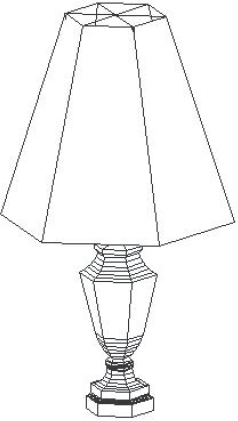Chapter 23. Creating 3D Surfaces
IN THIS CHAPTER
Converting objects to surfaces
Drawing surfaces with 3DFACE and PFACE
Creating 3D polygon meshes
Creating plane surfaces
Drawing standard 3D shapes
Drawing a revolved surface
Creating extruded, ruled, lofted, and edge surfaces
Working with surfaces, solids, and wireframes together
In this chapter, you learn to create all types of surfaces, also called meshes. Surfaces have a great advantage over 3D wireframe models because you can hide back surfaces and create shaded images for easier visualization of your models. Surfaces also enable you to create unusual shapes, such as for topological maps or free-form objects.
Note
This entire chapter applies to AutoCAD only. For information on surfaces that AutoCAD LT can create, see Chapter 21.
Figure 23.1 shows a lamp drawn with surfaces.
You cannot obtain information about physical properties — such as mass, center of gravity, and so on — from surfaces. Such information can be obtained only from 3D solids, which are covered in the next chapter.
AutoCAD approximates curved surfaces by creating a mesh of planes at varying angles. You see the planes because AutoCAD displays them using a web of intersecting lines. AutoCAD defines the mesh by its vertices — where the lines intersect. Figure 23.2 shows a mesh with its vertices.

Figure 23.1. A lamp drawn with surfaces.
Figure 23.2. A surface mesh.
Converting Objects ...
Get AutoCAD® 2008 and AutoCAD LT® 2008 Bible now with the O’Reilly learning platform.
O’Reilly members experience books, live events, courses curated by job role, and more from O’Reilly and nearly 200 top publishers.

